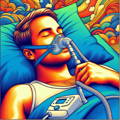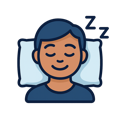Can Myofunctional Therapy Reduce CPAP Pressure? What the Latest 2025 Studies Mean for Ottawa Sleep Apnea Patients
Unlock Your Airway with an Easy, Custom Exercise Plan!
“Adding just 10 minutes of targeted oral–pharyngeal exercises a day dropped average APAP pressures by 1 – 2 cm H₂O in three months.”1
Why Letting CPAP Run Too High Can Backfire
| Why it’s a problem | How it feels at night |
|---|---|
| Higher settings (>10 cm H₂O) boost mask-leak risk by ≈ 12 %.(Aetna) | Hissing sounds, dry mouth, aerophagia |
| Leaks or discomfort cut average nightly use to < 4 h.(Aetna) | Morning fatigue despite “using the machine” |
| Pressure often creeps up over time unless anatomy changes. | Download report shows “95 % at 12+ cm H₂O” |

Mid-Night “Hissing” & Mask Leaks
High airflow lifts the seal, wakes you (or your partner), and forces the machine to ramp even higher to compensate.
Dry Mouth—Cavities & Sore Throats Follow
Pressurized air sneaks out through the lips, leaving tissues parched and cavity-prone by morning.
Pressure Creep Over Time
Ongoing leaks trick auto-adjusting devices into dialling pressures higher and higher, creating a frustrating cycle of intolerance.
Stomach Bloating & “CPAP Burps”
Excess pressure pushes air into the esophagus, leading to gassiness, reflux, and next-day discomfort.
Less Time on the Machine
Leaks and discomfort trim your nightly use below the therapeutic 4-hour mark—undoing all those sleepy-time gains.
Morning Congestion & Sinus Infections
Constant high-velocity airflow dries out nasal passages, triggers rebound swelling, and can set the stage for recurrent sinus headaches or infections.
How Myofunctional Therapy Helps
Strengthens airway muscles
Targeted toning of the lips, tongue and soft-palate to open your airway.
Reduces mouth leaks
Sleep therapy training closes the lips. This posture keeps air where it belongs, increasing oxygen and promotes deeper sleep.
Improves nasal flow/Breathing
Diaphragmatic nasal breathing increases flexibility of the blood vessels, decreasing inflammation, promoting homeostasis of the body.

Boosts adherence
Average nightly CPAP use climbs 30–40 min after 12 weeks of therapy.
Beyond the Basics: 5 Orofacial Myology Power-Ups for Better CPAP Nights
| OMT Power-Up | What It Trains | Why Your CPAP Loves It |
|---|---|---|
| 1. Diaphragm Warm-Up (5 slow belly breaths) | Nasal, negative-pressure breathing | Starts each night with a clear nose and lower flow resistance—fewer leaks before you even press “On.” |
| 2. “Tongue to The Spot” Suction Holds | Palatal seal & mid-tongue strength | A firm tongue-palate bond stiffens the upper airway so your machine can deliver gentler pressure. |
| 3. Soft-Palate “K” Lifts | Elevates soft palate & uvula on each very soft “kuh” | Tones the velopharyngeal port—the floppy tissue many auto-adjust units keep cranking up to splint. |
| 4. Lip-Seal Drill → Gentle Tape Rehearsal | Orbicularis oris tone & closed-mouth habit | Trains a leak-proof seal under the mask cushion; daytime practice makes nighttime taping safe and comfortable. |
| 5. Lateral Pterygoid Stretch + Wide-Smile Swallow | Releases jaw tension, widens retromolar space | Relaxed jaws cut clenching that can nudge the mask askew and trigger pressure spikes. |
These exercises are only a glimpse of the full Oral-Facial Advantage program; with guided coaching and steady practice, you can achieve substantial, measurable improvements.
Sources:
Sung J et al. Effect of Orofacial Myofunctional Therapy on APAP Pressure Needs (3-month cohort, 2025). PubMed
Li S et al. Myofunctional Therapy for Obstructive Sleep Apnoea: Systematic Review (2024). NCBI
Sleep Positional Therapy crossover trials (2024-25). PubMed JCSM
ResMed blog summary of Swedish humidifier study (2024). Resmed
SleepApnea.org guide to leak sources (2024). SleepApnea.org
CPAP hygiene & infection review (2025). PMC
How Orofacial Myofunctional Therapy Helps
We perform a 360º OMT 2 hour assessment at our Ottawa clinic to pinpoint each patient’s unique mix of factors.
Assessment
Airway screening, muscle tone tests, photos & measurements.
Personalized exercises
One-on-one coaching and exercise plan.
Habit reinforcement
Bi-Weekly check‑ins, daytime and sleep‑therapy strategies.
Take home message
Your CPAP is powerful, but it doesn’t need to blast air all night. Conditioning the muscles behind your airway—plus a few pro tweaks—lets the machine relax and you sleep deeper.



